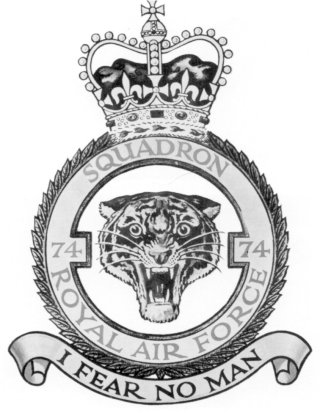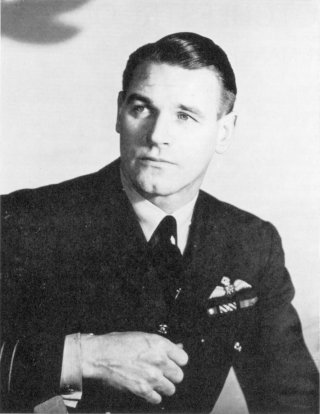

 The South African
The South African
by Sqn. Ldr. D. P. TIDY, M.A. A.S.A.I.M.
Lieutenant van Ryneveld was unfortunately killed later in the 1914-1918 war flying a Sopwith Camel with another formation, but his brother Sir Pierre van Ryneveld, was wing-commander of XI Wing, in which No. 74 Squadron served as a fully operational service squadron in France from the day the R.A.F. was born, lst April, 1918.
Sir Pierre was one of the two pioneer aviators who made the first flight from Britain to South Africa, and a statue of him, with his co-pilot Sir Quentin Brand (under whom I served in 1941) stands at Jan Smuts Airport, Johannesburg.
Flying SE (Scouting Experimental) 5a aircraft, the Squadron became known as "Tiger Squadron", because of its fierce attacking spirit, and its badge was a tiger's head with wings. It later took the present form of a tiger's face with the motto, "I Fear No Man" beneath. How justified this was is shown by the fact that the Squadron shot down 100 enemy aircraft in the first 83 days in France, and before the war ended in November, 1918, had increased this total to 225.

The Squadron Badge
Flying with Captain "Mick" Mannock, V.C., D.S.O. (and two bars), M.C. (and bar) who was the number one ace of World War I, with 73 victories, South Africans "Dixie" Kiddie, D.F.C., "Zulu" Savage, "Swazi" Howe, C.J. Venter, D.F.C. and W.L. Harrison, D.F.C. shot down at least fifty more. Tigers indeed! (Lieutenant, now Major-General, C.J. Venter, C.B., D.F.C., was a Flight Commander in No. 29 Squadron, but often used to join forces with No. 74 in combat.)
In 1919 the Squadron was disbanded, but soon after its re-formation in 1935, South African "Sailor" Malan, the greatest of them all, joined the Tigers. By an odd coincidence, both he and I served in the Royal Air Force for ten years; both were posted to only one squadron, 74, and both came to work for Mr. Harry Oppenheimer; "Sailor" with Anglo-American and I with African Explosives.
Group Captain Adolph Gysbert Malan, D.S.O. (and bar), D.F.C. (and bar), Belgian Croix de Guerre, Czecho-Slovakian Military Cross, French Legion of Honour in the degree of Officer and French Croix de Guerre with Palm (which decorations of his may be seen in the South African National War Museum, Johannesburg), joined 74 after several years as an officer in the Union Castle Line, from which seagoing service he derived his nickname. His wife Lynda always called him John, and it was by this name that he was known to a few of his closest friends, but to his Squadron as a whole, and to the world, he was, and always will be "Sailor". He was the outstanding fighter pilot of the 1939-1945 war, and by the end of June, 1941, was the top scorer with 29 enemy aircraft destroyed, a record which he held for three years. His inspired leadership, added to his gunnery and implacable determination, made him second to none, a fact most generously acknowledged by the man who, late in 1944, eventually passed his score of victories, Air Vice-Marshal J.E. Johnson, C.B.E., D.S.O., D.F.C. "Sailor" was perhaps, a man who more than any other, could say in all truth: "I Fear No Man."

Group-Captian A.G. 'Sailor' Malan, D.S.O. (and bar), D.F.C. (and bar),
Croix de Guerre (Belgium), Croix de Guerre (France),
Legion d'Honneur (France)
In 1943, with No.7 Squadron South African Air Force, the Squadron took part in the disastrous invasion of Cos Island in the Dodecanese, and our aircraft flew with theirs to continue the old association, until all were lost.
1944 saw the Squadron back over Europe for the invasion, and South African Lieutenants Bob Human and "Tookie" Tooke flying with the Squadron. Tragically before the invasion, South African Lieutenant Harries was lost in the sea off Brightlingsea on 3rd May, 1944, while flying with the Squadron, and was buried in Upwood Military Cemetery near Farnborough.
"Sailor" Malan had by now shot down three more to make his score 32, and in January 1945, Bob Human (by then a Captain) became "B" Flight Commander.
At the end of the 1939-1945 war the Squadron converted from piston-engined Spitfires to jet Meteors, followed some years later by Hunters. Then later still, they were the first Squadron to receive the Lightning, and, once again, in 1960, a South African Commanding oflicer, Squadron-Leader J.F.G. Howe.
John Howe, educated at St. Andrews College, Grahamstown, flew with the South African Air Force in Korea, and joined the Royal Air Force in 1954, already holding the American D.F.C. and Air Medal. With him in the Squadron was yet another South African, Flying-Officer Jacques W. Kleynhans, educated at Jeppe High School, Johannesburg. He was an accountant before joining the R.A.F. in 1957.
It was altogether fitting that when Her Royal Highness The Princess Margaret presented the Standard to the Squadron on 3rd June, 1965, the man who received it as Standard Bearer was yet another South African, Flying Officer R.H.N. Rhodes. The selected battle honours inscribed on the Standard are: Western Front 1918; France and Low Countries 1940; Dunkirk; Battle of Britain 1940; Fortress Europe 1940-41-44; Mediterranean 1943; Normandy 1941; France and Germany 1944-1945. South Africans were there with the Squadron every time.
It is equally fitting that splendid examples of the only three types of aircraft flown by these gallant South Africans of No. 74 Squadron in two world wars, the SE5, Hurricane and Spitfire, are housed in the South African National War Museum in Johannesburg.
Today the Squadron is in the Far East and the partnership of the Springbok and the Tiger continues in Malaysian skies; for over fifty years it has flourished in the greatest fighter squadron of all time.
(EDITOR'S NOTE: We are indebted to Squadron Leader D.P.Tidy for this most interesting article. Squadron Leader Doug Tidy served with No. 74 Squadron in the 1939-45 war, visiting Durban in early 1942, on his way to the Western Desert. He is now completing the full definitive history of the Squadron, which he anticipates will be published during 1968.)
Return to Journal Index OR Society's Home page
South African Military History Society / scribe@samilitaryhistory.org